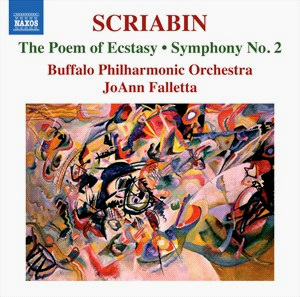

Symphony No. 2 in C minor, Op. 29 The Poem of Ecstasy, Op. 54 (Symphony No. 4)
For the purpose of this review I will focus my attention on the Symphony No. 2 in C minor from 1901, since any or all of Alexander Scriabin's three official symphonies are rarely performed or recorded when compared to his extensive piano works, or to the other orchestral work on this recording, the Poem of Ecstasy completed in 1908. This visionary tone poem has seen its ample share of stupendously "ecstatic" recordings to date.
The booklet notes point out that English music critic and musicologist Wilfrid Howard Mellers later wrote: "Scriabin whipping himself into ecstasy is not so different from that other cosmopolitan Russian, Tchaikovsky, whipping himself into fury or despair: except that Scriabin's melodic vitality is so much lower." Quite a misunderstanding, and inaccurate comparison in my opinion. For one thing, Alexander Scriabin (1872-1915) never sounded Russian in the "intrinsic" or "endemic" sense of the word. Unlike the highly melodic, folklore-inspired narrative and concepts employed by Rimsky-Korsakov, Tchaikovsky, Mussorgsky, Borodin, etc ... Scriabin's style and technique, strongly influenced by Wagner, was focused on motivic and thematic development, complex and adventurous harmonic intervals and progressions, more akin to composers like Alexander Zemlinsky, Gustav Mahler, Richard Strauss, etc ... Bold, sweeping romanticism rather than brooding melancholy.
Like many of the best symphonies, what sets the music in motion at the start, comes around full circle in the end, completely developed and transformed into its foremost potential. Conductor JoAnn Falletta well captures, nuances and stresses the myriad number of ascending motivic cells throughout each movement that lend the whole symphony a probing reach for its elysian pursuit. The orchestra is in top form, and uniformly balanced even during the most congested climactic passages. The gentle birdsong entrance of the slow movement is very well projected, as well as its polished string writing. The generous acoustics of the Kleinhans Music Hall in Buffalo do the opulence of the orchestral score full justice.
Jean-Yves Duperron - February 2023 Tempestoso - Symphony No. 2